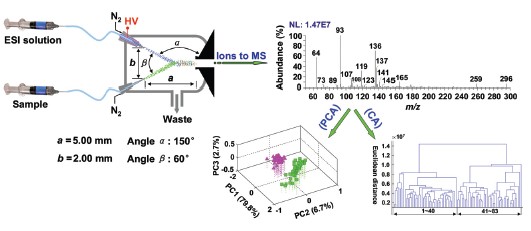| [1] Domínguez, M. J. N.; Durán, D.; Chamorro, M. P. V.; Arroyo, R. M. J. Int. Sci. Vigne. Vin. 2010, 44, 179. [2] Shen, F.; Yang, D.; Ying, Y.; Li, B.; Zheng, Y.; Jiang, T. Food Bioprocess Tech. 2012, 5, 786. [3] Contreras, U.; Barbosa-García, O.; Pichardo-Molina, J.; Ramos-Ortíz, G.; Maldonado, J.; Meneses-Nava, M.; Ornelas-Soto, N.; López-de-Alba, P. Food Res. Int. 2010, 43, 2356. [4] Ali, K.; Maltese, F.; Toepfer, R.; Choi, Y. H.; Verpoorte, R. J. Biomol. NMR 2011, 49, 255. [5] Guadalupe, Z.; Martínez-Pinilla, O.; Garrido, á.; Carrillo, J. D.; Ayestarán, B. Food Chem. 2012, 131, 367. [6] Toci, A. T.; Crupi, P.; Gambacorta, G.; Dipalmo, T.; Antonacci, D.; Coletta, A. J. Mass Spectrom. 2012, 47, 1104. [7] Arroyo-Manzanares, N.; García-Campaña, A. M.; Gámiz-Gracia, L. Anal. Bioanal. Chem. 2011, 401, 2987. [8] Cynkar, W.; Dambergs, R.; Smith, P.; Cozzolino, D. Anal. Chim. Acta 2010, 660, 227. [9] Chen, H. W.; Touboul, D.; Jecklin, M. C.; Zheng, J.; Luo, M. B.; Zenobi, R. Eur. J. Mass Spectrom. 2007, 13, 273. [10] Chen, H. W.; Hu, B.; Zhang, X. Chin. J. Anal. Chem. 2010, 38, 1069. (陈焕文, 胡斌, 张燮, 分析化学, 2010, 38, 1069.)[11] Li, X.; Hu, B.; Ding, J. H.; Chen, H. W. Nat. Protoc. 2011, 6, 1010. [12] Jia, B.; Zhang, X. L.; Ding, J. H.; Yang, S. P.; Chen, H. W. Chin. Sci. Bull. 2012, 57(20), 1918. (贾滨, 张兴磊, 丁健桦, 杨水平, 陈焕文, 科学通报, 2012, 57(20), 1918.)[13] Xu, N.; Zhu, Z. Q.; Yang, S. P.; Wang, J.; Gu, H. W.; Zhou, Z.; Chen, H. W. Chin. J. Anal. Chem. 2013, 41(4), 523. (许柠, 朱志强, 杨水平, 王姜, 顾海巍, 周振, 陈焕文, 分析化学, 2013, 41(4), 523.)[14] Gu, H. W.; Yang, S. P.; Li, J. Q.; Hu, B.; Chen, H. W.; Zhang, L. L.; Fei, Q. Analyst 2010, 135, 779. [15] Yang, P. R. Liquor-making Science & Technology 2003, (4), 106. (杨佩荣, 酿酒科技, 2003, (4), 106.)[16] Zhu, S. K.; Lu, X.; Ji, K. L.; Guo, K. L.; Li, Y. L.; Wu, C. Y.; Xu, G. W. Anal. Chim. Acta 2007, 597, 340. [17] Hu, B.; Chen, H. W.; Zhang, X.; Yang, S. P.; Feng, S. H. Acta Chim. Sinica 2009, 67(12), 1331. (胡斌, 陈焕文, 张燮, 杨水平, 冯守华, 化学学报, 2009, 67(12), 1331.)[18] Yang, D. W.; Fan, X. L.; Kind, T.; Fiehn, O.; Guo, R. B. Acta Chim. Sinica 2013, 71, 663. (杨大伟, 范晓蕾, Kind Tobias, Fiehn Oliver, 郭荣波, 化学学报, 2013, 71, 663.)[19] Zhu, L.; Hu, Z.; Gamez, G.; Law, W. S.; Chen, H. W.; Yang, S. P.; Chingin, K.; Balabin, R. M.; Wang, R.; Zhang, T. T.; Zenobi, R. Anal. Bioanal. Chem. 2010, 398, 405. [20] Zhang, X. L.; Jia, B.; Huang, K. K.; Hu, B.; Chen, R.; Chen, H. W. Anal. Chem. 2010, 82, 8060. [21] Jia, B.; Ouyang, Y. Z.; Sodhi, R. N.; Hu, B.; Zhang, T. T.; Li, J. Q.; Chen, H. W. J. Mass Spectrom. 2011, 46, 313. [22] Zhu, Z. Q.; Yan, J. P.; Wang, Y.; Chen, S. Z.; Chen, H. W. Chin. J. Anal. Chem. 2013, 41(6), 905. (朱志强, 闫建平, 汪雨, 陈瞬宗, 陈焕文, 分析化学, 2013, 41(6), 905.)[23] Luo, L. P.; Wang, J.; Zhang, W. J.; Dai, X. M.; Fang, X. W.; Zhang, X.; Liu, Y. L.; Chen, H. W. Chin. J. Anal. Chem. 2013, 41(7), 1050. (罗丽萍, 王姜, 章文军, 戴喜末, 方小伟, 张茜, 刘亚丽, 陈焕文, 分析化学, 2013, 41(7), 1050.)[24] Chen, H. W.; Liang, H. Z.; Ding, J. H.; Lai, J. H.; Huan, Y. F.; Qiao, X. L. J. Agric. Food Chem. 2007, 55, 10093. [25] Hua, L.; Wu, Q. H.; Hou, K. Y.; Cui, H. P.; Chen, P.; Wang, W. G.; Li, J. H.; Li, H. Y. Anal. Chem. 2011, 83, 5309. [26] Geissler, R.; Saraji-Bozorgzad, M. R.; Gröger, T.; Fendt, A.; Streibel, T.; Sklorz, M.; Krooss, B. M.; Fuhrer, K.; Gonin, M.; Kaisersberger, E. Anal. Chem. 2009, 81, 6038. [27] Li, C.; Zhou, Y. F.; Tan, G. B.; Liu, Y. L.; Gao, W.; Zhou, Z.; Chen, H. W.; Ouyang, Y. Z. Chin. J. Anal. Chem. 2013, 41(9), 1359. (李操, 周亚飞, 谭国斌, 刘亚丽, 高伟, 周振, 陈焕文, 欧阳永中, 分析化学, 2013, 41(9), 1359.)[28] Li, M.; Hu, B.; Li, J. Q.; Chen, R.; Zhang, X. L.; Chen, H. W. Anal. Chem. 2009, 81, 7724. [29] Chen, H. W.; Wortmann, A.; Zhang, W. H.; Zenobi, R. Angew. Chem. Int. Ed. 2007, 46, 580. [30] Gu, H. W.; Hu, B.; Li, J. Q.; Yang, S. P.; Han, J.; Chen, H. W. Analyst 2010, 135, 1259. [31] Chen, H. W.; Yang, S. P.; Li, M.; Hu, B.; Li, J. Q.; Wang, J. Angew. Chem. Int. Ed. 2010, 49, 3053. [32] Chen, H. W.; Venter, A.; Cooks, R. G. Chem. Commun. 2006, 42, 2042. [33] Chen, H. W.; Zenobi, R. Nat. Protoc. 2008, 3, 1467. |
